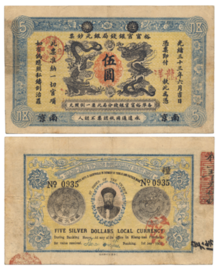
The paper money of the Qing dynasty (Traditional Chinese: 清朝鈔票) was periodically used alongside a bimetallic coinage system of copper-alloy cash coins and silver sycees; paper money was used during different periods of Chinese history under the Qing dynasty, having acquired experiences from the prior Song,[1] Jin, Yuan, and Ming dynasties which adopted paper money but where uncontrolled printing led to hyperinflation.[2][3][4] During the youngest days of the Qing dynasty paper money was used but this was quickly abolished as the government sought not to repeat history for a fourth time; however, under the reign of the Xianfeng Emperor, due to several large wars and rebellions (most notably the Taiping Rebellion), the Qing government was forced to issue paper money again.[5][6][7]
The reason why the government was forced to reform the imperial monetary system with a very complex system during the Taiping Rebellion was because the rebels had blocked the access of mint metals from the southwest of China, but more money was still needed to fight the ongoing insurgency.[8] The advisors of the Xianfeng Emperor not only introduced copper-alloy cash coins with higher denominations than one, as well as introducing new cash coins made of metals other than brass, but also revived paper money in the shape of the Xianfeng baochao (咸豐寶鈔).[9][10] Quite important for the war effort is the fact that the imperial Qing government earned some revenue by issuing these new types of currencies.[11]
During the latter half of the 19th century various foreign banking corporations and credit institutes started doing business in China. The paper notes issued by these companies started circulating in China leading to many local companies imitating their designs and even outsourcing the production of paper money. The strong influence of these foreign banks had a modernising effect on both the economy and the currency of the Qing dynasty, leading to the imperial government issuing their own versions of modern paper money. The denominations on the paper money were as chaotic as that of the coinage types and the different exchange rates used regionally were also applied locally, while banknotes denominated in copper-alloy currency had a different value than banknotes denominated in silver currency. Concurrently banknotes issued by different branches or different banks were also discounted with paper bills issued by more reliable banks being both valued more and in higher demand than those issued by institutions with a less favourable reputation.
In the early 20th century the government of the Qing dynasty attempted to decimalise the currency among many other economic reforms and established a central bank to oversee the production of paper money; however, the chaotic monetary situation continued to plague interregional trade and would later be inherited by the Republic of China.
- ^ Glahn, Richard von (2006). "Re-Examining the Authenticity of Song Paper Money Specimens", Journal of Song-Yuan Studies, 36: 79-106.
- ^ Bernholz, Peter (1997). "Paper Money Inflation, Prices, Gresham's Law and Exchange Rates in Ming China", Kredit und Kapital, 30/1: 35-51.
- ^ Chen, Chau-Nan, Chang Pin-Tsun, Chen, Shikuan. "The Sung and Ming Paper Monies: Currency Competition and Currency Bubbles", Journal of Macroeconomics, 17/2: 273-288.
- ^ Li, Kangying (2007). "A Study on the Song, Yuan and Ming Monetary Policies against the Context of Worldwide Hard Currency Flows during the 11th-16th Centuries, and their Impact on Ming Institutions and Changes", in Angela Schottenhammer, ed. The East Asian Maritime World 1400-1800: Its Fabrics of Power and Dynamics of Exchanges (Wiesbaden: Harrassowitz), 99-136.
- ^ Huang Da (黃達), Liu Hongru (劉鴻儒), Zhang Xiao (張肖), ed. (1990). Zhongguo jinrong baike quanshu (中國金融百科全書) (Beijing: Jingji guanli chubanshe), Vol. 1, 94. (in Mandarin Chinese)
- ^ Wu Chouzhong (吳籌中) (1993). "Zhongguo gudai zhibi (中國古代紙幣)", in Zhongguo da baike quanshu (中國大百科全書), Wenwu boguguan 文物·博物館 (Beijing/Shanghai: Zhongguo da baike quanshu chubanshe), 784. (in Mandarin Chinese).
- ^ Xie Tianyu (謝天宇), ed. (2005). Zhongguo qianbi shoucang yu jianshang quanshu (中國錢幣收藏與鑒賞全書) (Tianjin: Tianjin guji chubanshe), Vol. 2, 506, 508. (in Mandarin Chinese).
- ^ Niv Horesh (2019). The Monetary System of China under the Qing Dynasty. Springer Link. pp. 1–22. doi:10.1007/978-981-10-0622-7_54-1. ISBN 978-981-10-0622-7. S2CID 158146530.
- ^ Williams, S. Wells (1975). "Paper Money among the Chinese", T'ung Pao: Journal of the Society for Oriental Numismatics, 1/2: 38-40 [reprinted from The Chinese Repository, 20 (1851)].
- ^ Rowe, William T. (2010). "Money, Economy, and Polity in the Daoguang-Era Paper Currency Debates", Late Imperial China, 31/2: 69-96.
- ^ Kaske, Elisabeth (2015). "Silver, Copper, Rice and Debt: Monetary Policy and Office Selling in China during the Taiping Rebellion", in Jane Kate Leonard, Ulrich Theobald, ed. Money in Asia (1200 – 1900): Small Currencies in Social and Political Contexts (Leiden/Boston: Brill), pages 343–397.